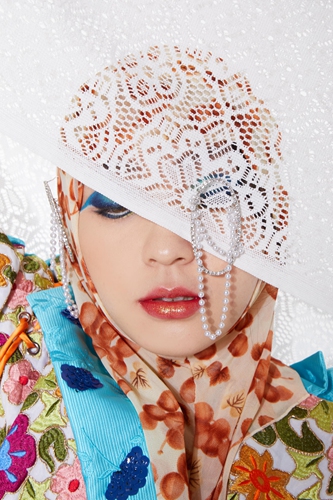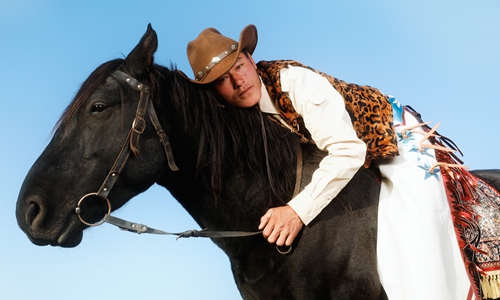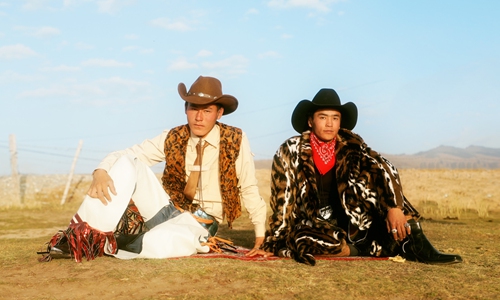Chinese photographer from Xinjiang: I want to show how cool Xinjiang is
By Ji Yuqiao Source:Globaltimes.cn Published: 2020/4/20 23:54:04

Photo: Courtesy of Ma Hailun
Unibrows, henna and colorful long dresses, as well as the clothing worn by herders, all of these common attires demonstrating the regional characteristics of Northwest China's Xinjiang Uygur Autonomous Region have become a major fashion trend for a young Chinese photographer born in the region.
After studying photography in New York for eight years, Ma Hailun, 26, finally decided to return to her hometown to continue her art career, because Xinjiang is where she fell in love with fashion.
"When I walked down the streets of Urumqi when I was younger, I saw people wearing such colorful clothes that showed off their beauty and vitality, which made a huge impression on me," Ma told the Global Times.
"After stepping into the fashion industry, I came to understand that is the fashion style I have always loved."
Ma has taken several photos series dedicated to Xinjiang and the people living in the region. She said her aim is to use these photos to debunk some of the stereotypes people may have about the beautiful multi-ethnic place and add a layer of cool to the region in the minds of others.
Capturing a different view
Many of Ma's photos of Xinjiang were taken during road trips she has taken around the region. While on these trips, she drove through the pastoral areas and mountainous areas of Xinjiang so she could take photos of her subjects outside in a true natural environment.
Most of Ma's works were born of her seizing random moments of opportunity that mostly came from her intuition. She said she only needs one glimpse while traveling down the road to recognize a good subject.

Photo: Courtesy of Ma Hailun
A series of photos displaying herders called Xinjiang Cowboys were taken in a pastoral area in the Ili Kazak Autonomous Prefecture after Ma ran into a group of young Kazakh men riding horses.
Upon seeing them, she immediately pulled her car over and asked if they were willing to play the lead roles in her photo series. After they agreed, she began to snap shots of them under a clear blue sky.
In the series of photos, young Kazakh men in hats dressed in local ethnic clothing sit or lie on a black horse. Both the men and the horse's eyes are full of emotion, looking as if they have numerous stories to tell.
Ma said that she once visited the state of Texas while studying in the US. This provided her with the opportunity to experience the state's cowboy culture, which made her realize that Xinjiang too has lots of herders and a rich nomadic culture. She chose to shoot a cowboy theme for these photos to draw in more young people overseas and help get a step closer to Xinjiang.

Photo: Courtesy of Ma Hailun
"This is what I am trying to do, using a novel and modern lens to package Xinjiang's traditional cultural symbols. I think it will attract young people," Ma noted.
"I hope my works can open a door that allows people to get to know the real Xinjiang from a new perspective, instead of just through beautiful fixed scenic pictures online. At the same time, it also enables Xinjiang residents to have a deeper understanding of their hometown's beauty and discover things that we take for granted."
Ma said she is also looking to capture the Xinjiang from her childhood, when everything seemed more colorful.
In her photos, Uygur women are dressed in modified sequined skirts, with colorful scarves draped over their shoulders, coupled with their carefully painted eyebrows, making a bold combination.
With cash in their stockings and nails colored with dye from henna flowers, these women are not afraid to show off colors that are noisy but real and passionate.
Many Xinjiang people don't have much, but each one is able to make good use of what they have, and mix it up to create a very personal style that has great vitality, Ma explained.
Growing up in Xinjiang
Growing up in Urumqi, Ma gained an interest in cameras at a very early age due to her father, who was a host at a local TV station. However, it was really only after she began studying photography in New York at the age of 18 that she, as part of the Han ethnic majority, began to better understand the charm of the place where she was born.
In New York, Ma saw an emptiness beneath the fantasy of allegedly high-level fashion photography and became determined to show more real people, more real emotions and more real fashion in her work. Therefore, she turned her camera on people of all ages in Xinjiang, who dressed their own way.
She thought that no matter if they are big-hearted women or dashing men in Xinjiang, or even the newly emerging post-2000 generation, they are subverting people's outlook on the region.
Once Ma went to a pasture in the Altay Prefecture that was not open to tourists. She lived with some local herders who did not have access to electricity or the internet. She said at that time, it felt like she was living in a completely pure land.
The nearby still lake waters, the trained eagles that landed on the yurts and the night sky full of shining stars were sights that she had seldom seen growing up in the city. There was a boy who seemed as if he had walked out of a Hayao Miyazaki film. This picturesque beauty made the young photographer even more determined to show Xinjiang to the world.
Xinjiang is an eternally new subject for Ma. Although she grew up in the region, it wasn't until she began taking photos that she began understanding some traditions, such as using makeup to connect one's eyebrows into a unibrow.
"I was not able to appreciate the charm of a unibrow like many other people when I was younger, but now I can see the style's beauty, especially after learning its meaning. Brows represent vitality in tradition so longer brows are more preferable."
She noted that there are still lots of charming points in Xinjiang for her to explore.
"I have shot many series about Uygur and Kazak people, but Xinjiang still has dozens of ethnic minorities that are not well known. After the COVID-19 pandemic ends, I will continue touring and creating to show off the cool side of Xinjiang," she said.
Posted in: PHOTOGRAPHY